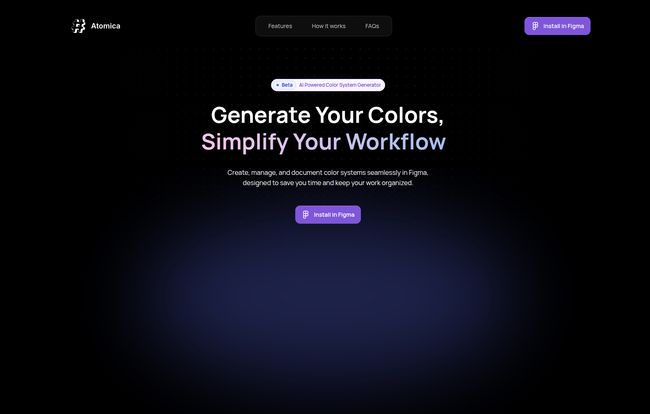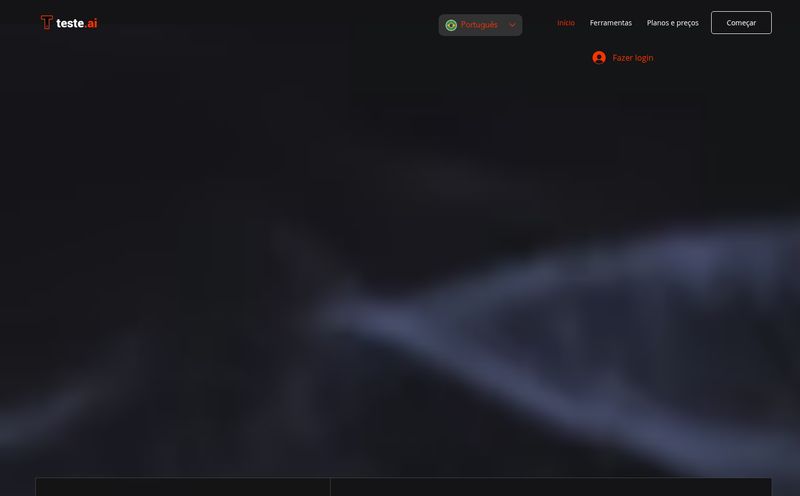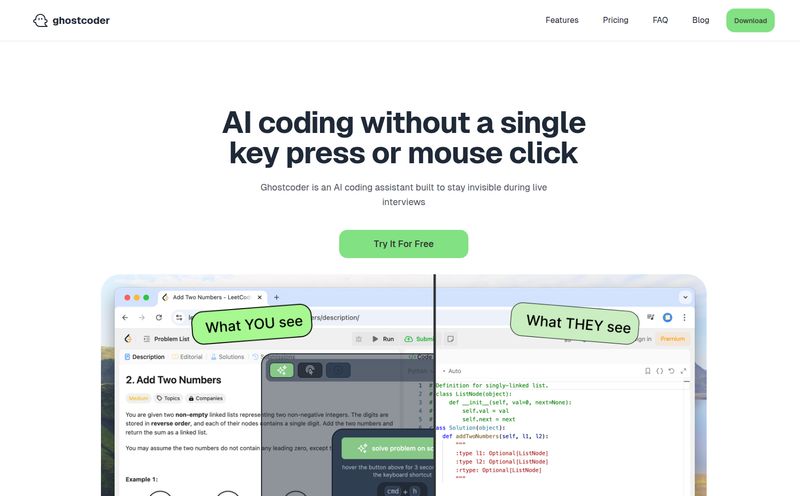We've all been there. Staring at a Figma file that looks like a paint factory exploded. You've got 'Final Blue,' 'Final Blue V2,' 'Johns_Blue_DO_NOT_USE,' and about fifty shades of grey that somehow all look identical. Managing color systems, especially on large projects, can feel less like design and more like digital archeology. It's a pain we've all just... accepted. A necessary evil.
So when a new tool pops up promising to “revolutionize” and “streamline” this exact process, my inner cynic and my hopeful inner designer get into a fistfight. The latest contender entering the ring is a slick-looking plugin called Atomica. It claims to be an AI-powered color companion for Figma, designed to bridge that all-too-familiar gap between design and development.
But does it live up to the hype? I decided to install it and find out.

Visit Atomica
First Off, What is Atomica Anyway?
At its core, Atomica is a Figma plugin built to take the grunt work out of creating, managing, and documenting your color palettes. Think of it as a specialized assistant who lives inside your Figma workspace. Its main job is to keep your colors organized, help you generate new palettes when you're feeling uninspired, and make sure your developers get exactly what they need without you having to manually copy-paste a thousand hex codes. It's built by a team called Atomica Studio, and they’re swinging for the fences, aiming to simplify the entire color workflow from concept to code.
My First Impressions and the Onboarding Experience
The landing page is clean. Dark mode, minimalist, straight to the point. It speaks the language of a modern design tool. The big, shiny button says “Install in Figma,” and that’s exactly what I did. The installation is as simple as any other Figma plugin, which is a good start. No hoops to jump through.
I will say, the website feels very new. I clicked around on a few of the links in the header, like 'FAQs', and was met with a classic 'Page Not Found' error. Now, this could be a bad sign, but in my experience, it usually just means a product is in its early stages—probably a beta. It gives me the sense that I'm looking at something fresh off the press, which is kind of exciting. It’s not a deal-breaker, just something that tells you the paint is still drying on the walls.
The Atomica Features That Actually Matter
A tool is only as good as what it helps you accomplish. Here’s a breakdown of what Atomica brings to the table.
AI-Powered Palette Generation: Your New Creative Spark
This is the headline feature. Atomica’s AI can generate entire color palettes for you. Feeling stuck on a new project? Just give the AI a nudge and it will spit out a range of options. It's like having a junior designer on hand whose sole purpose is to brainstorm color combinations until you see something you like. A massive time-saver for those initial mood-boarding phases.
Now, here's the catch for the beta/free version: you get 5 AI generations per day. It’s a classic freemium model, and honestly, it’s fair. It's enough to get a feel for the tool without giving away the whole farm. I imagine a paid plan with unlimited generations is on the horizon.
Collection Management for a Sane Workflow
This might actually be my favorite part. Atomica lets you organize your colors into 'Collections.' You can create different sets for different projects, or even for different states within a single project (like primary colors, secondary, and notification colors). It transforms the potential chaos of Figma’s native color styles into a tidy, structured system.
It’s the difference between a meticulously organized toolbox and a rusty bucket full of random screws and bolts. One helps you build things efficiently, the other gives you a headache. For anyone working on a design system, this level of organization is non-negotiable.
Design-Ready Exports and a Smoother Dev Handoff
Here it is. The feature that promises to mend the broken bridge between designers and developers. Once your palette is set, Atomica lets you export the entire system. We're talking formats that developers actually use. While the site doesn’t specify every single format, tools like this typically export to CSS variables, JSON, or even Swift/XML code snippets. This is huge.
No more devs having to use a color-picker tool on your JPEG exports. No more back-and-forth about whether they’re using `#0A0B0C` or `#0B0C0D`. It’s about creating a single source of truth that both teams can work from. That alone is worth its weight in gold.
The Good, The Bad, and The Beta
So, let's get down to brass tacks. What’s great and what’s just… okay?
The biggest pro is the workflow acceleration. The combination of AI for inspiration and strong organizational tools for management is a potent mix. It genuinely feels like it could save hours on any given project. The focus on easy exports also shows they understand a critical industry pain point.
On the con side, it obviously requires you to be a Figma user, so if you're still rocking Sketch or Adobe XD, this isn't for you. The 5-per-day AI generation limit on the free version is a bit of a tease, but again, that's expected. It's more of a limitation to be aware of than a true flaw.
| The Upsides | The Downsides |
|---|---|
| AI-powered palette generation is a huge time-saver. | Limited to 5 AI generations daily in the free beta. |
| Excellent collection management keeps colors organized. | Only works within Figma. |
| Easy export options streamline developer handoff. | Being in beta, some website elements are unfinished. |
| Unlimited color creation and storage. | Future pricing is currently unknown. |
So, What’s the Price Tag?
This is the million-dollar question, isn't it? As of my review, there is no pricing information available. The plugin is free to install and use from the Figma community, with the limitations I mentioned earlier. This strongly suggests Atomica is in a public beta phase.
My advice? Get in now. This is the best time to try a tool like this—while it’s free and the creators are hungry for feedback. You get to see if it fits your workflow without spending a dime.
My Final Verdict: Should You Install Atomica?
Yes. Absolutely. Especially since it’s currently free.
Atomica isn't trying to be a gimmick. It’s tackling a real, nagging problem that plagues design teams everywhere. It’s a specialized tool designed to do one thing—color systems—and do it really well. While it’s still early days for the plugin (as evidenced by the 'Page Not Found' errors), the foundation is incredibly solid.
If you're a UI/UX designer, part of a team building a design system, or even a freelancer who wants to bring more order to your creative chaos, give Atomica a shot. It might just be the color companion you didn’t know you needed. It’s a step in the right direction, and I, for one, am excited to see how it grows.
Frequently Asked Questions
What exactly is Atomica?
Atomica is an AI-powered plugin for the design tool Figma. It's built to help designers create, organize, manage, and export color systems more efficiently, simplifying the workflow between design and development.
Is the Atomica plugin free to use?
Yes, at the moment, Atomica is free to install and use from the Figma Community. It appears to be in a public beta, with some features like AI palette generation limited to 5 uses per day in the free version.
Do I need to have Figma to use Atomica?
Yes. Atomica is a plugin, not a standalone application. It functions entirely within the Figma design environment.
How does the AI palette generation work?
The AI in Atomica generates color palette suggestions to help kickstart your creative process. It's designed to provide inspiration and save you time when establishing the color scheme for a new project.
Can I export my color palettes for developers?
Yes, one of Atomica's key features is its ability to export your organized color systems. This helps create a single source of truth for colors and streamlines the handoff process to development teams.
Who is behind Atomica?
According to their website, Atomica is made by Ismail at Atomica Studio. It seems to be an independent project focused on solving a specific need within the design community.
Reference and Sources
For the most current information or to install the plugin, you can visit the official website. Please note that as of this writing, some sections of the site may be under construction.
- Atomica Official Website: https://atomica.cool/



